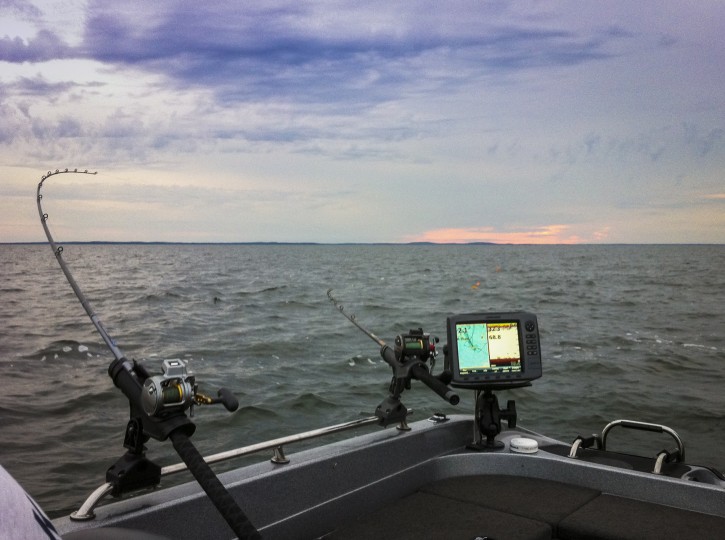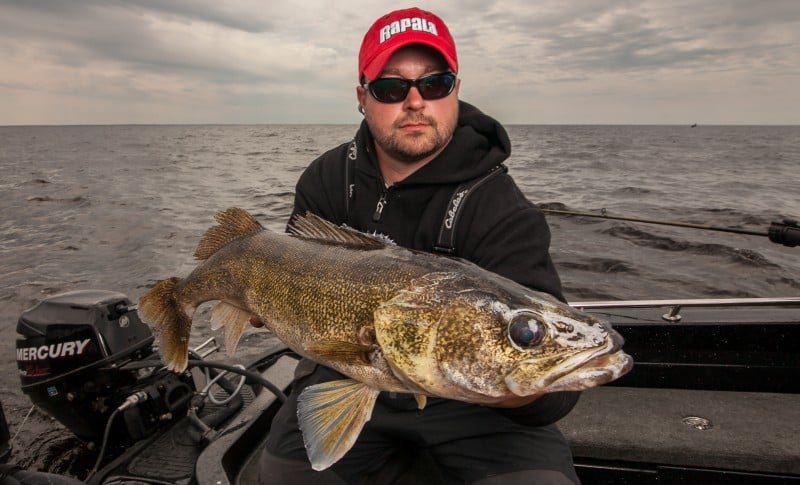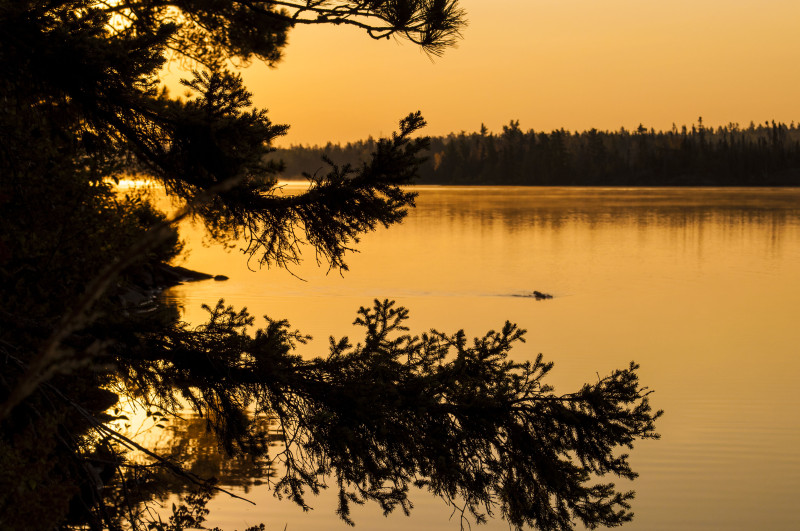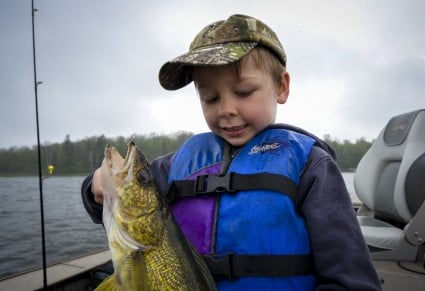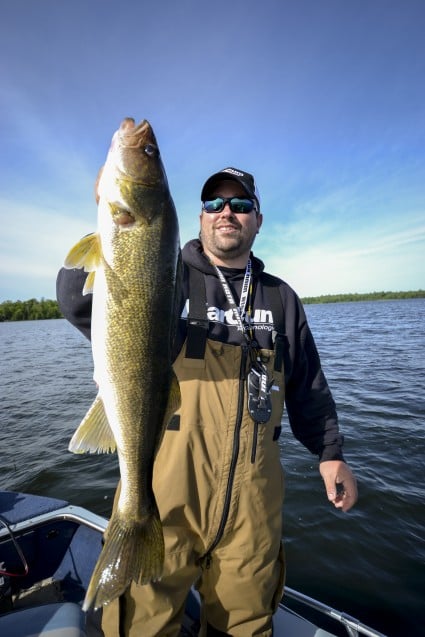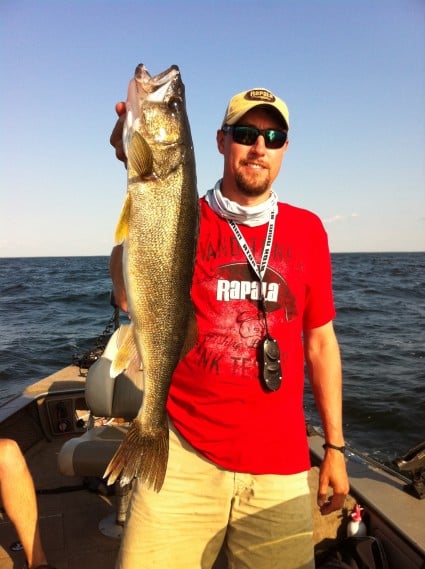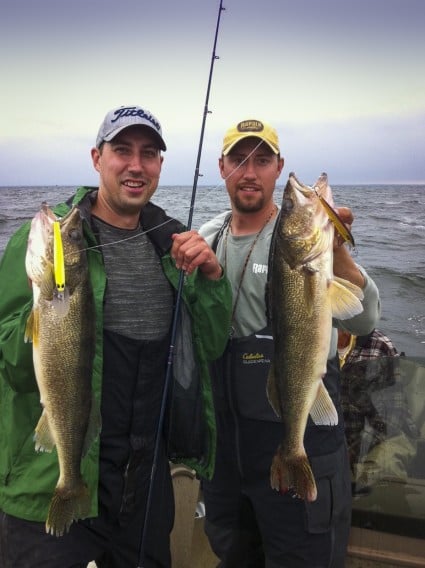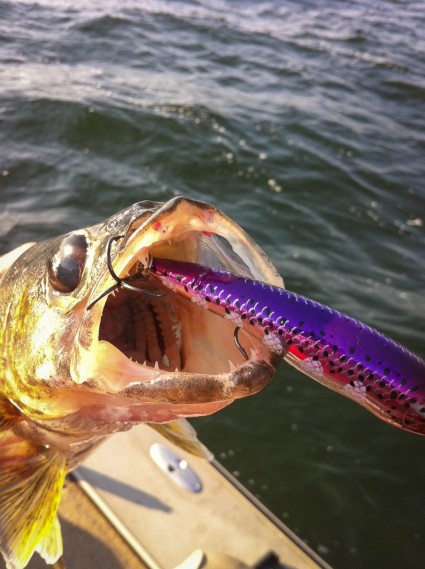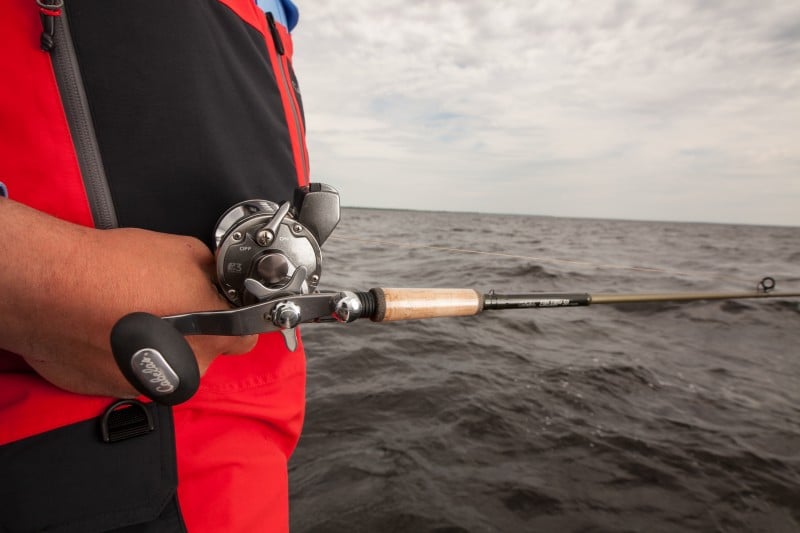Ask the Crew?
Aimlessly bobbing around in a boat on a swelteringly hot mid-summer day while swatting mosquitoes or the latest “bug hatch de jour” has a way of leaving an angler longing for the cool breezes of spring and those shallow-water walleye bites that dominate the first few weeks of the season.
We’ve all been there. Faced with 90 degree temps, oppressive humidity and a mix of sunscreen and sweat burning in our eyes, who hasn’t thought to themselves at least once “why can’t it be late May in walleye country forever?”
You remember those early season trips, right? The walleyes would gladly board your boat in hoards, and it didn’t matter if you were trolling, jigging or rigging- the bite was hot and heavy and most anglers could do no wrong.
But all good things come to an end and all it took was those first couple stretches of hot, humid weather and it was as if somebody flipped a switch. The fish moved from the shallows, competing food sources appeared almost overnight in imposing quantities and those once suicidal hoards started to act more like dinners at a buffet on their third return trip.
But this doesn’t mean fish can’t be caught mid-summer. In fact, the opposite it true. With the fishes’ metabolism cranked up and mass quantities of food readily available, the challenge faced by all anglers under these circumstances is two-fold.
1-Find the fish.
2-Convince the fish to eat YOUR offering instead of the myriad of other delectable morsels.
To get some valuable insight on how best to approach this scenario we asked Joel Nelson and Will Roseberg, both In-Depth Outdoors Pro staffers, to offer their perspectives on how to be successful at this time of the year.
Joel Nelson
There is a very specific formula I have devised for enticing mid-summer walleyes with live bait.
Right off the bat, as mid-summer wears on I will concentrate more and more of my time fishing during low light conditions, with the morning peak bite window getting the majority of my attention. The reason is two-fold, less pressure and more consistent light levels. Fishing the morning becomes even more productive when the full moon approaches, and it starts to set right before the sunrise. Making a point to be on the water by 4:00 am – 5:00 am allows for some time to work out the kinks before the prime time bite begins right before sunrise. Every bite can be hard earned this time of year so it is important to be on you’re A-game when the key bite window is open.
First things first when getting on the water, I need to locate where fish are actively feeding. Fish, often are in the same area the wind left them from the previous night, and even when not in the exact same locations, they’re typically not too far away. Using that piece of knowledge, it’s good to start with pieces of structure buffeted by wind in days or hours previous. My favorite places to fish mid-summer walleyes are always the easiest pieces of cover or structure to stay on the fish with as the day progresses. This would include underwater points, or small, isolated rock humps just off shore. I stay away from the large complexes of reefs, with hundreds of intricate twists/turns and choose to attack those during mid-day. These locations are great if you have the time to figure them out, but when prime time happens, you need to be on simple spots to find fish quickly.
When I get out on the water, before sunrise, I will start fishing up against scattered weeds from 9-14 feet, especially at the shoreline-end or base of any underwater point. As morning light grows brighter and the sun angle increases, fish push out along the point all the way to mid-level depths (15-22 feet) by 9AM or later. With a big enough piece of structure, you’re able to stay on the same fish, keeping bait in their face during their entire march down the point into deeper water (22+ feet).
The next crucial aspect is choosing and presenting my offering. In the morning, I need to cover water relatively quickly, and put my bait in front of fish which are actively feeding. My go to technique for covering water, and triggering walleyes is a spinner rig with a crawler. Fish during this period can be very picky about how they want their meal, and small games of tug-of-war with crawlers and leeches are not often tolerated. This is where a few different tricks, and choices in presentation come into play. When fishing scattered weeds in the morning, a 3/8 to 1/2 ounce bullet sinker will offer the best weedless presentation, allowing both weight and spinner rig to dance through the upper portions of the weedbed. I do this with the same spinning rods I rig with and it works well. I like to make my spinner rigs with a section of 6 foot 12 lb. Sufix Invisiline, as it offers stealth and the ability to break off just the hook rather than your whole rig if you happened to get snagged. As fish push off deeper during the morning, I trade spinning rods for pre-rigged baitcasting rods that have 2 ounce VMC Switch-It Bottom Bouncers and spinners ready to go. I will also have somebody in the boat who is fishing a 10 foot snell. This makes life a bit more difficult in controlling the rig, and especially in netting fish, but I’ve seen many days where it pays dividends, most often in clearer water.
More anglers in the boat equals more color, bait, and rig-length varieties to help solve the puzzle. If I am running 3 to 4 people in the boat, the front two anglers have a 2 – 3 ounce sinker on, and the back two have a 1 ½ ounce to get further back from the boat and spread the lines out.
As for hook color and size, I’m a big fan of chartreuse and pink in as large as I can get away with. The larger I go, the easier time I have avoiding gut hooking the fish. Size #2 is often a staple when tying up rigs. Most often, I use contrasting color beads to the hook and spinner, as I feel this aids in visibility of the bait. For the spinner blades, it’s hard to beat a Colorado. It allows you to keep the blade spinning at lower speeds, where as an Indiana or willow blade will need faster speeds to operate correctly. A #2 to #4 blade, is the size range I will stick with, depending on the mood and size of fish. As a general rule of thumb, larger and more aggressive fish, a large blade will produce better. On big fish bodies of water such as Eire or Lake of the Woods, I have fished up to a #7 blade, and the fish couldn’t get enough of it.
For the waters I spend the majority of time on, a #2 or #3 blade will allow me to catch fish for the frying pan, with the potential for larger fish. Blade colors will vary a lot, depending on the body of water. A metallic color such as silver or gold is deadly on clear water, where fluorescent colors like orange or chartreuse produce better in dingy water. If you see on your graph there is a bug hatch happening, I will have somebody put on a brown blade to imitate the emerging insects. In saying that, almost any body of water I am fishing, somebody in the boat will have a hammered gold blade on. Again, when you’re not catching fish, change it up!
Pay attention when you are working a break, as you make turns up and down the break, your outside rig will move quicker, while the inside will move slower. If you keep getting hit on the outside rod, you will want to increase your speed, and the opposite is true of an inside rod.
Many people fish spinners very statically, they tie on a blade color in a certain size and color and fish it all day. I fish spinners like many people fish crankbaits, constantly switching sizes, colors, speeds, until I find the combination the fish can’t resist!
When pulling spinners, if you feel the weight of the fish, just drop the rod back a bit and let the forward motion of the boat pick-up the slack as you sweep the rod forward. Putting the rod in holders will get you bit, but mid-summer typically requires you to hold the rod to both give the fish a bit of time to eat, and to properly hook-up. Getting them to get the whole bait in their mouth becomes more of a challenge than anything else, so start by using slightly smaller leeches, and trimming crawlers just past the last hook. Often, while pumping the rod slightly to attract fish, you can see walleyes that follow on the electronics at times for 20 yards or more until they hit. During times like this, it’s crucial to allow those follower fish to catch up by slowing the boat, and/or drop the sinker to let them watch the leech or worm wriggle for a while. Quite often the fish will be already on when you pick your sinker back off the bottom.
As the guy who captains the boat, it’s your responsibility to inform your fellow fisherman of the small clues that you’re continually seeing on the graph. Everyone benefits in the end, and you put a lot more fish in the boat by letting your buddy know that a fish has been following his setup for the past minute. Drowning bait can be a passive technique that lulls people into in-attention, and keeping up your concentration, as well as in-boat morale is important. Probably the best tip I could offer the boat driver is to blow past/through poor water if the fish are concentrated. When fish are spread and sporadic, spinners and faster speeds around 1.0 mph to upwards of 1.5 mph will cover more water which is the ticket. When they’re more concentrated, don’t waste time pulling over un-productive water. When you do find fish, dropping the speed to right around 1 mph will keep your blades spinning and baits in the strike zone for a greater period of time.
Pay attention when you are working a break, as you make turns up and down the break, your outside rig will move quicker, while the inside will move slower. If you keep getting hit on the outside rod, you will want to increase your speed, and the opposite is true of an inside rod.
Many people fish spinners very statically, they tie on a blade color in a certain size and color and fish it all day. I fish these presentations like many people fish crankbaits, constantly switching sizes, colors, speeds, until I find the combination the fish can’t resist!
Will Roseberg
While most anglers seem to dread the on-set of the Dog Days of summer, on my home waters of Mille Lacs Lake in Central Minnesoota, I’ve actually come to look forward to it. And for two primary reasons, the pattern I like at this time of year produces some of my biggest walleye of the season and it is actually quite simple to use.
The way I approach midsummer walleye is to troll large, deep diving crankbaits through roaming schools of walleye relating to balls of baitfish. Sound simple? I promise, once you have the basics down, it is!
Before I get into the details of the presentation itself I feel one of the best pieces of advice I can give anglers looking to improve their catch rates midsummer fishing this method is to be willing to let go of their structure fishing mentality. Prime structure like inside turns, steep breaks and reefs are a great place to catch walleye, right?
I know we’ve all invested a lot of time and effort into learning how to read our GPS mapping units, learned how to pick prime fish-holding structure and fish it effectively but hitting the water with this mindset at this time of year can actually be a detriment. The walleye I’m targeting mid-summer are often found adjacent to but not directly relating to structure of any kind. I’m fishing flats. Huge, expansive soft-bottom flats in the center of Mille Lacs Lake free from any appreciable depth change for mile after trolling mile.
So why would the fish be out on these flats instead of hanging on prime structure midsummer? The answer, simply, is food.
These huge flats have a very soft, silty bottom composition and make the perfect home to an almost endless variety of invertebrates that fuel the food chain. Daily bug hatches made up of millions of individual insects slowly rise up off the bottom towards the surface and look almost like smoke rising from a chimney when seen on a fish finder. These bug hatches attract walleye and balls of baitfish looking for an easy meal. Hungry walleye, their metabolism cranked up in response to the warm water temperatures, feast on both the invertebrates and baitfish.
The best places to start your search is adjacent to nearby structure such as rock reefs or mud flats; however walleyes will follow wherever the baitfish lead and can often be found miles away from the nearest structure. As I said earlier, this is one time when you’ll often find many more fish out in what is often referred to as “No Man’s Land” than on the structure itself.
But this certainly doesn’t mean you’ll be blindly trolling without purpose or direction. Perhaps the most important key to success in the basin is to become confident in reading your electronics and to trust the information being displayed. As you build confidence you can actually start to feel like you’re in touch with your quarry’s mood and intentions by what you see on the screen. Fish holding tight to the bottom are usually resting, while fish detected several feet above bottom or even suspended in the middle of the water column are likely active and ready to eat. Paying attention to this type of information and knowing how to adapt your presentation is key to being a successful basin angler.
In my boat the beginning of each trip for basin walleyes involves a scouting period where I’m looking for both walleyes and the presence of bug hatches and / or baitfish. What I want to see is multiple fish shown suspended in the water column near a baitfish column or mass of emerging bugs. The more fish graphed the better, obviously.
If I can find this scenario I’ll drop a waypoint, make careful note of the depth of those fish, then circle around back upwind to make a trolling pass with crankbaits set to run just above the heads of the fish. Every spot shown to be holding feeding walleye will get a waypoint icon on my GPS. I do the same for every fish caught. One quick look at my GPS shows me where I’ve found fish scouting, where I’ve caught fish trolling and, just as importantly, the areas devoid of good looking sign.
On the other hand, fish marked tight to bottom, even if shown in large numbers will rarely get my immediate attention. I have learned that this scenario deserves to be rechecked later in the day. A big school of inactive fish in the morning will often fire up and get active later in the day. Saving a waypoint for an inactive school of fish and remembering to check back in on them has turned a slow day into a memorable one for me on multiple occasions!
Once located, my favorite tactic for boating open basin walleyes is to take advantage of their need for big meals by targeting them with large deep-diving crankbaits. Starting in the middle of June my boat doesn’t leave the dock without a half dozen Plano boxes full of TD-11 Rapala Tail-Dancers and Storm Deep Thundersticks.
Each trip starts by running multiple colors and styles of baits on different rods, with my #1 favorite big walleye bait being a TD-11 Purple Clown Flash Taildancer. Given the choice to pick one lure this would be it, but for anyone who may be just starting out and looking for a few suggestions my other top producers are a Chrome/Blue Storm Deep Thunderstick with the red bill and the Clown TD-11 Taildancer.
The depths I’m fishing on Mille Lacs Lake when using this presentation will primarily be in the 32’ – 34’ range. At these depths I’m able to position my baits anywhere I need them in the water column without additional weight when using the list of crankbaits I shared previously. I run 6# diameter, 20# test Sufix 832 braided line on my trolling rods as it provides amazing sensitivity and, due to its thin diameter, allows to reach fish holding just above bottom if need be by running nearly 200’ of line out to the bait.
Most active fish will be found in the 28’ – 22’ range meaning I usually run baits back 90’ – 130’ back behind the boat to put my lures in the productive zone. If I have multiple people in the boat I put out a “spread” of lines (The rule is one line per person in Minnesota) and run a variety of my favorite lures at staggered depths until we find the hot combination. On windy days it is common to catch fish on rods fished in rod holders mounted to the boat. On calm days I feel that planer boards, which get the lures out to the side of the boat to avoid spooking, are an absolute must in clear water.
The beauty of this pattern is that once dialed it is very repeatable on virtually any large body of water with a healthy population of large baitfish. From my home waters on Mille Lacs to Leech, Lake of the Woods and even on the Great Lakes I’ve had success using this approach on them all and I’m confident that with a little time on the water you’ll never get bitten by the dog days again.
Watch Will Roseberg and James Holst put these tactics to work on Mille Lacs
